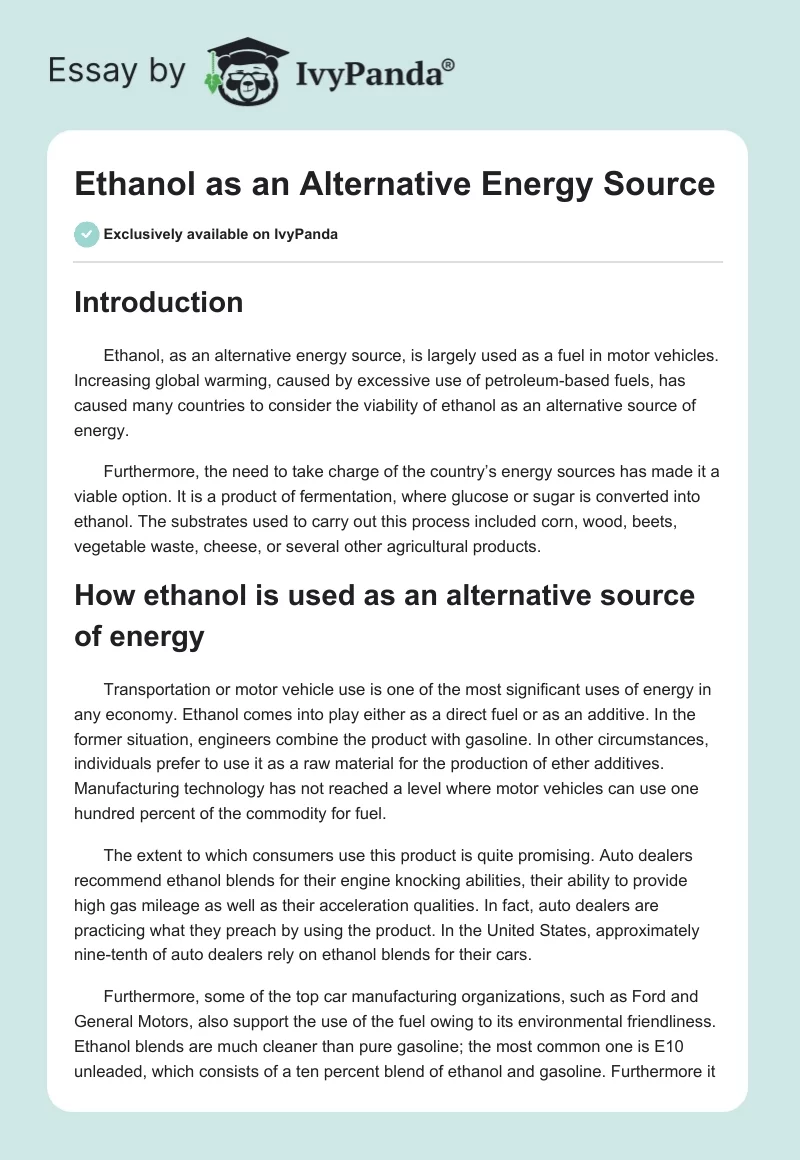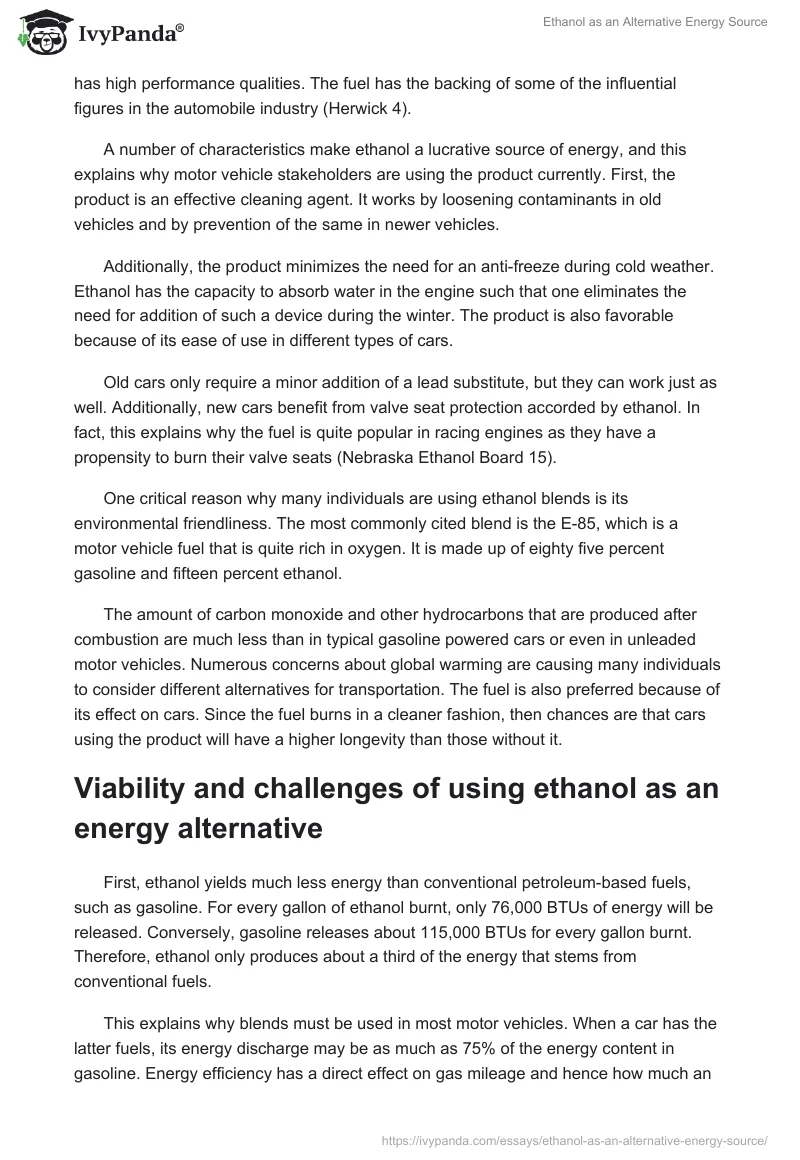Introduction
Ethanol, as an alternative energy source, is largely used as a fuel in motor vehicles. Increasing global warming, caused by excessive use of petroleum-based fuels, has caused many countries to consider the viability of ethanol as an alternative source of energy.
Furthermore, the need to take charge of the country’s energy sources has made it a viable option. It is a product of fermentation, where glucose or sugar is converted into ethanol. The substrates used to carry out this process included corn, wood, beets, vegetable waste, cheese, or several other agricultural products.
How ethanol is used as an alternative source of energy
Transportation or motor vehicle use is one of the most significant uses of energy in any economy. Ethanol comes into play either as a direct fuel or as an additive. In the former situation, engineers combine the product with gasoline. In other circumstances, individuals prefer to use it as a raw material for the production of ether additives. Manufacturing technology has not reached a level where motor vehicles can use one hundred percent of the commodity for fuel.
The extent to which consumers use this product is quite promising. Auto dealers recommend ethanol blends for their engine knocking abilities, their ability to provide high gas mileage as well as their acceleration qualities. In fact, auto dealers are practicing what they preach by using the product. In the United States, approximately nine-tenth of auto dealers rely on ethanol blends for their cars.
Furthermore, some of the top car manufacturing organizations, such as Ford and General Motors, also support the use of the fuel owing to its environmental friendliness. Ethanol blends are much cleaner than pure gasoline; the most common one is E10 unleaded, which consists of a ten percent blend of ethanol and gasoline. Furthermore it has high performance qualities. The fuel has the backing of some of the influential figures in the automobile industry (Herwick 4).
A number of characteristics make ethanol a lucrative source of energy, and this explains why motor vehicle stakeholders are using the product currently. First, the product is an effective cleaning agent. It works by loosening contaminants in old vehicles and by prevention of the same in newer vehicles.
Additionally, the product minimizes the need for an anti-freeze during cold weather. Ethanol has the capacity to absorb water in the engine such that one eliminates the need for addition of such a device during the winter. The product is also favorable because of its ease of use in different types of cars.
Old cars only require a minor addition of a lead substitute, but they can work just as well. Additionally, new cars benefit from valve seat protection accorded by ethanol. In fact, this explains why the fuel is quite popular in racing engines as they have a propensity to burn their valve seats (Nebraska Ethanol Board 15).
One critical reason why many individuals are using ethanol blends is its environmental friendliness. The most commonly cited blend is the E-85, which is a motor vehicle fuel that is quite rich in oxygen. It is made up of eighty five percent gasoline and fifteen percent ethanol.
The amount of carbon monoxide and other hydrocarbons that are produced after combustion are much less than in typical gasoline powered cars or even in unleaded motor vehicles. Numerous concerns about global warming are causing many individuals to consider different alternatives for transportation. The fuel is also preferred because of its effect on cars. Since the fuel burns in a cleaner fashion, then chances are that cars using the product will have a higher longevity than those without it.
Viability and challenges of using ethanol as an energy alternative
First, ethanol yields much less energy than conventional petroleum-based fuels, such as gasoline. For every gallon of ethanol burnt, only 76,000 BTUs of energy will be released. Conversely, gasoline releases about 115,000 BTUs for every gallon burnt. Therefore, ethanol only produces about a third of the energy that stems from conventional fuels.
This explains why blends must be used in most motor vehicles. When a car has the latter fuels, its energy discharge may be as much as 75% of the energy content in gasoline. Energy efficiency has a direct effect on gas mileage and hence how much an individual spends on fuel. If a person enjoyed a gas mileage of 28 miles on every gallon, then this amount may reduce to 20 miles. Consequently, the driver would have to visit the fuel station more regularly. Ethanol-based sellers would also have to make the fuel slightly more expensive to compensate for the extra energy that is required to meet vehicle needs.
Some challenges may also arise when one hundred percent ethanol is used in motor vehicles. In cold temperature, the fuel may not vaporize readily. This implies that cars may not start during the winter. In this regard, specialists have come up with the maximum amount of ethanol that can be used in motor vehicles without compromising on the vaporization capabilities of the vehicle. 15%, as seen in the E85 blend, is what is permissible in most cars. However some cars can use up to 22% ethanol in production.
There are currently about 4 million E85 cars in the US market. However, infrastructure required to meet their needs is not yet sufficient. This means that consumers have to consider the ease of availability of the fuel before purchasing them, and this may affect the viability of the energy source. Additionally, the number of E85 vehicles is still not sufficient to meet the demands of most consumers in the US market. Car manufacturers require an incentive that will encourage more of them to participate in this initiative.
The prevalence of motor vehicle hybrids is also diverting attention away from ethanol-based vehicles. The government has to split its attention between hybrids and ethanol powered automobiles. Most times, key stakeholders may not realize the potential of ethanol as a fuel source, and this may harbor investment in the same. Studies indicate that subsidization of hybrids is more costly than ethanol fuel production. Therefore, more of this information needs to be spread to lawmakers.
Currently, the country is in need of a fuel standard for all the states. Renewable energy sources often have to overcome this hurdle before their proliferation can be fully realized. They people who are affected by them may have to do something to standardize use.
Some of the challenges involved in the production and use of ethanol in automobiles require a lot of research and development. Studies are still not sufficient to overcome these hurdles. Advocates of alternative fuels need to channel resources towards such initiatives in order to make ethanol even more viable.
A challenge also exists in access to ethanol. Since the product must be created from agricultural products, then individuals in the industry need to partner with several stakeholders that already operate in the agricultural sector. Furthermore, business start ups in ethanol production are not sufficient enough to encourage greater production of the fuel. Renewable energy is always a noble place to build entrepreneurial skills, and ethanol production is yet to rise to that occasion.
Perhaps another huge challenge in addressing the viability of ethanol fuel is the raw material used for production. Most ethanol in the US comes from corn, yet corn is a food item. Several biofuels have created a lot of controversy owing to their reliance on food items. This brings to bear the plausibility of the fuel.
One must consider waste products such as sawdust, animal waste, grass, industrial waste and rice husks as potential replacements. However, the ease of availability of these wastes must also be put in question. The country needs to think of creative ways of harnessing these resources by borrowing from other countries that have used such residues successfully (Prasad et. al. 3).
Conclusion
Ethanol holds a lot of promise as an alternative source of fuel. Not only does it produce fewer pollutants in the atmosphere, but it also contributes to longer vehicle life along with a number of other advantages. The fuel does have some limitations, such as reliance on food products as raw materials, low fuel economy, difficulties in vaporization, poor availability of infrastructure for use. The use of blends, greater investment and more research can mitigate these problems as an alternative energy.
Works Cited
Herwick, Gary. The case for using a sensible alternative fuel. 2012. Web.
Nebraska Ethanol Board 2012. Ethanol-blended fuels. 2012. Web.
Prasad, Sanjay, Singh, Anoop, Joshi, Hamit. “Ethanol as an alternative fuel from agricultural, industrial and urban residues.” Resources, Conservation and Recycling 50.3(2007): 1-39. Print.


